<% ns_puts [mkm_getnavbar] %>

Myth of the Wrist:
The Backhand
by John Yandell
Still photos by J. Gregory Swendsen
|
How entrenched is the myth of the wrist? Recently I
was speaking at a twilight tennis dinner at a Northern California tennis
club. I showed the members some of the Advanced Tennis Research high speed
footage of Andre Agassi’s forehand (www.AdvancedTennis.com),
demonstrating how his wrist remained laid back until long after the ball
had gone from the strings (Myth of the Wrist,
part 1).
The footage really opened their eyes, and the talk
was a big success. Sitting at the bar afterwards, however, I was
approached by one of the club’s most avid players, a guy in his 40’s
who had been playing for about four years. He told me that I “might”
have convinced him on the forehand, but he was still certain the wrists
played a critical role in his two-handed backhand.
|
My new friend was far from alone, of course, in his
view of role of the wrists on the two-handed backhand. There are even some
coaches who argue that wrist action is important in hitting with one hand.
For example, a well-known tennis writer who also
teaches tennis has been adamant for years that to hit topspin with the one-hander
the player must “roll the racquet head over the ball” with a violent
upward movement of the wrist and elbow just before contact. Strangely he has never connected this theory to his own (chronic) case of
tennis elbow.
The major problem in understanding the correct wrist
position on either backhand--as with the forehand--is the extremely brief
time interval in which the racquet is moving through the contact zone. In a
literal sense we are all “hitting blind,” and also, watching blind. This is because the contact between the ball and the
racquet occurs too
fast for the human eye or conventional video cameras to register clearly.
|
Advanced Tennis high speed video of top players, shot
at 250 frames a second, demonstrates that in reality the role of the wrist
is passive for both the one-handed and two-handed backhands. This is
completely analogous to the role of the wrist on the forehand.
As you can see for yourself looking at the video here
and in the first article on the forehand, the movement of the wrist occurs
many frames after the hit. This is light years after the critical
instant of the contact in the high speed world of professional tennis.
It appears that the wrist and/or arm movement after
the hit is a reaction to the force of the hit, or part of the recovery
motion to relax and prepare for the next ball. Each stroke has a
characteristic wrist position that is established at the start of, or just
after the start of the foreswing, a position that is maintained well out
into the followthrough.
The Two-Hander
Most coaches who truly understand the bio-mechanics
of the two-hander agree that the stroke is extremely similar to the
classical forehand. A good two-handed backhand is like a classical
forehand, but hit with the opposite hand (See Robert Lansdorp’s article
on the two-hander). Like a forehand, this means the hitting arm is
set up in the power position as the racquet moves forward to the ball. This
hitting arm position has two elements: the elbow is bent and tucked
in toward the waist, and the palm of the hand is laid back. This is
what I call the double bend or power palm position.

Some players, such as Marcelo Rios keep it very
simple and maintain this precise hitting arm position, moving straight
forward and through the ball. This approach is by far the simplest model
for club players, or in fact, players at any level to copy.
Other pro two-handers, including Andre Agassi and
Llleyton Hewitt, will often turn the wrist and racquet head downward at an
angle of about 45 degrees as they start of the foreswing. Depending on the
ball, they may also extend their arms somewhat as they move through the
hit, straightening their elbows. However, the wrist will remain laid
back, and the double bend position is usually reestablished as they move
through the followthrough.
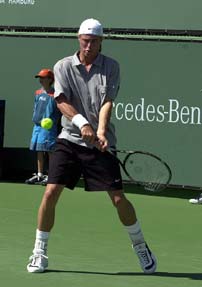 |
 |
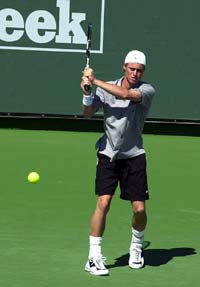 |
Note how Lleyton Hewitt’s wrist is laid
back before contact (1), after the contact (2), and at the end of the
followthrough and the start of the “wrapping” motion backwards away
from the hit (3).
|
||
In fact two-handed players will often extend the laid
back wrist position further out into the followthrough than on the
forehand. This is because the grip with the dominant left hand tends
to be less extreme than on the forehand side.
Agassi’s grip with his left hand, for example, is a
classical eastern, compared to his right-handed forehand grip which is
semi-western. Even a player like Hingis, who probably has the most
extreme two-handed grip of the current top pros, uses a mild semi-western
with her dominant left hand, roughly the same as her forehand side.
Compare this to the forehands of so many pros, who are farther underneath the handle with their grips on the forehand side.
|
The confusion regarding the role wrist on the
forehand is usually related to these more extreme grips and the
correspondingly extreme internal arm rotation, where the racquet head and
arm turn over after the hit with the wrist breaking forward.
On the two-handed backhand, however, the confusion
regarding the wrist usually stems from the so-called “wrap”
followthrough, in which the hands and wrists actually move upward and
backward at the end of the followthrough, finishing over the shoulder and
often, wrapped around the neck. Many players and coaches--including
my friend from the twilight tennis dinner--believe this action of bringing
the racquet and wrists sharply upward is the key to pace and topspin.
In reality, this motion occurs long after the hit,
when the ball has been off the strings for many milliseconds. Equally important, the
racquet, hitting arm and wrists have already
extended well outward through the line of the shot and upward in front of
the body, prior to the beginning of this motion.
As the high speed video shows, the hands and butt of
the racquet reach about eye level before the arms and wrists release
and start backwards in the so-called “wrap” finish. This extension
through the hit and upward to eye level represents the technical end of
the swing pattern.
As with the release of the wrist on the forehand, the
”wrapping” action on the backhand is a consequence rather than a cause
of a great forward swing. The wrap is a reaction to action of the
foreswing and the hit. It is part of the relaxation and
recovery response, rather than a part of the technical forward swing
pattern.
But too many players confuse reaction with action in trying to develop this stroke. Players who try to physically emulate the wrap invariably are much too short through the hitting zone. They try to mechanically bring the racquet up and force the “wrap” rather than letting it happen naturally. They may learn to hit with topspin, but often they produce far too much topspin relative to the speed of their ball. Although their backhands may have heavy spin, they tend to land short and lack pace.
This proved to be exactly the case when I filmed our
avid friend from the twilight dinner. As I expected, he had a
violent, upward followthrough and an exaggerated mechanical wrap finish. Although some of his balls had heavy topspin, few landed deeper than the
service line.
When we compared his backhand to the high speed video
of Rios and Agassi, he was able to see that his swing plane was far too
steep, his wrists released too early, and too much of his
energy was going into spin. By modeling his finish and hitting arm
positions on these two pro players, he was able to generate significantly
more pace and depth, and to do so almost instantaneously.
Go to page 2 |
Your comments are welcome. Let us know what you think about John Yandell's article by emailing us here at TennisONE.
|
For more information on John Yandell's Advanced Tennis Research Project, click here.
Last Updated 7/15/01. To contact us, please email to: webmaster@tennisone.com
TennisONE is a registered trademark of TennisONE and SportsWeb ONE; Copyright 1995. All rights reserved.

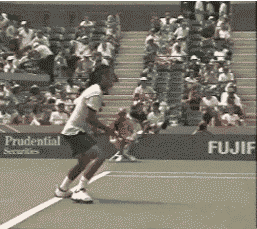
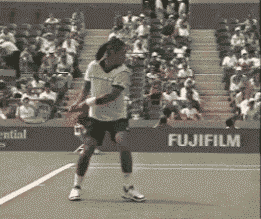
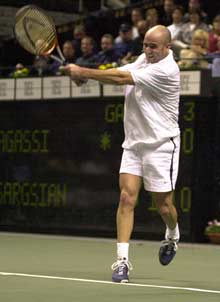
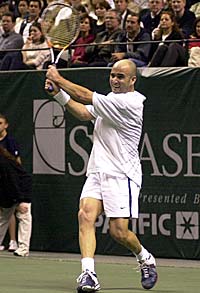
 Visual
Tennis
Visual
Tennis